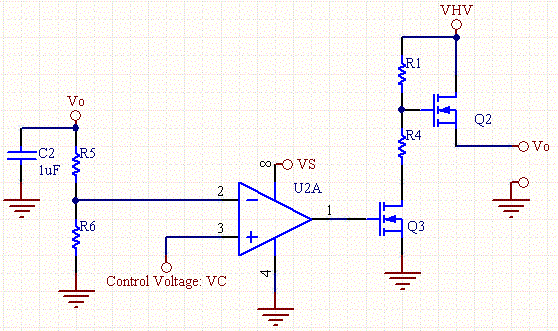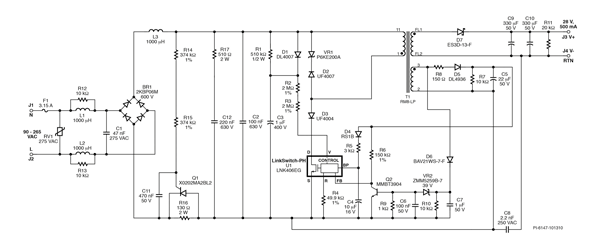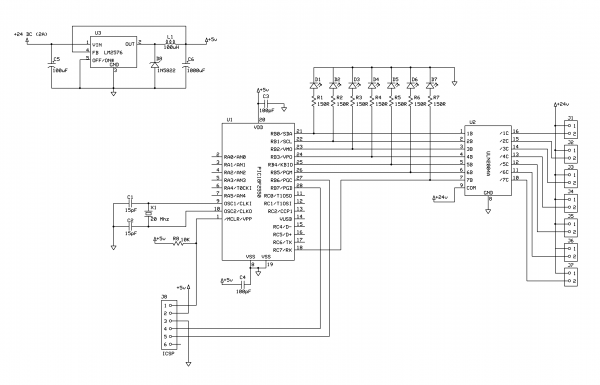
13 Color LED Rainbow

This circuit uses a set of 13 differently colored LEDs to generate a full color spectrum. The photo does not fully represent the colors generated due to camera limitations. The real-world display is very eye-catching. If you want to "trick out" your PC, this circuit is for you. Forget about those boring blue PC light displays.
The described circuit utilizes 13 different colored Light Emitting Diodes (LEDs) to create a visually appealing full color spectrum. Each LED emits light in a specific wavelength, contributing to the overall color display. The circuit design likely employs a microcontroller or similar programmable device to control the individual LEDs, allowing for dynamic color changes and patterns.
The microcontroller can be programmed to cycle through various color combinations, fade effects, or even respond to external inputs such as sound or user interaction. To achieve a full spectrum effect, the circuit may include RGB LEDs, which combine red, green, and blue light to produce a wide range of colors. Alternatively, the use of individual colored LEDs can also be arranged in a specific sequence to create the desired effect.
Power management is crucial in this circuit to ensure that each LED receives the appropriate voltage and current. Current-limiting resistors are typically included in series with each LED to prevent damage from excessive current. The circuit may also incorporate a power supply capable of delivering sufficient power to all LEDs simultaneously, especially during peak brightness conditions.
Furthermore, the layout of the LEDs can enhance the visual impact. Arranging them in a linear fashion, a matrix, or even in a circular pattern can create different aesthetic effects. Additionally, the use of diffusers or lenses may be implemented to soften the light output and blend colors more smoothly.
In summary, the circuit is designed to enhance the aesthetic appeal of a PC setup by utilizing a diverse array of LEDs to create a vibrant and dynamic color display, making it an attractive option for users looking to customize their systems beyond standard lighting options.This circuit uses a set of 13 differently colored LEDs to generate a full color spectrum. The photo does not fully represent the colors generated due to camera limitations. The real-world display is very eye-catching. If you want to "trick out" your PC, this circuit is for you. Forget about those boring blue PC light displays. 🔗 External reference
The described circuit utilizes 13 different colored Light Emitting Diodes (LEDs) to create a visually appealing full color spectrum. Each LED emits light in a specific wavelength, contributing to the overall color display. The circuit design likely employs a microcontroller or similar programmable device to control the individual LEDs, allowing for dynamic color changes and patterns.
The microcontroller can be programmed to cycle through various color combinations, fade effects, or even respond to external inputs such as sound or user interaction. To achieve a full spectrum effect, the circuit may include RGB LEDs, which combine red, green, and blue light to produce a wide range of colors. Alternatively, the use of individual colored LEDs can also be arranged in a specific sequence to create the desired effect.
Power management is crucial in this circuit to ensure that each LED receives the appropriate voltage and current. Current-limiting resistors are typically included in series with each LED to prevent damage from excessive current. The circuit may also incorporate a power supply capable of delivering sufficient power to all LEDs simultaneously, especially during peak brightness conditions.
Furthermore, the layout of the LEDs can enhance the visual impact. Arranging them in a linear fashion, a matrix, or even in a circular pattern can create different aesthetic effects. Additionally, the use of diffusers or lenses may be implemented to soften the light output and blend colors more smoothly.
In summary, the circuit is designed to enhance the aesthetic appeal of a PC setup by utilizing a diverse array of LEDs to create a vibrant and dynamic color display, making it an attractive option for users looking to customize their systems beyond standard lighting options.This circuit uses a set of 13 differently colored LEDs to generate a full color spectrum. The photo does not fully represent the colors generated due to camera limitations. The real-world display is very eye-catching. If you want to "trick out" your PC, this circuit is for you. Forget about those boring blue PC light displays. 🔗 External reference





